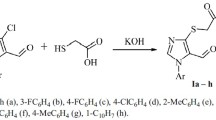Abstract
MANY pyrrolizidine alkaloids have toxic effects in the livers and sometimes the lungs of experimental animals1, and there is evidence that these effects are caused by metabolites formed by enzymic dehydrogenation of the alkaloids in the liver2–4. These metabolites are highly reactive dihydropyrrolizine esters which when released in the liver cell can react with nucleophilic tissue constituents. The heterocyclic moiety can become bound to the tissue while the acid moiety is liberated as the anion.
Similar content being viewed by others
References
Schoental, R., Israel J. Med. Sci., 4, 1133 (1968).
Mattocks, A. R., Nature, 217, 723 (1968).
Mattocks, A. R., J. Chem. Soc. (C), 1155 (1969).
Culvenor, C. C. J., Downing, D. T., Edgar, J. A., and Jago, M. V., Ann. NY Acad. Sci., 163, 837 (1969).
Schoental, R., and Mattocks, A. R., Nature, 185, 842 (1960).
Mattocks, A. R., J. Chem. Soc.,(C), 2698 (1969).
Butler, W. H., Mattocks, A. R., and Barnes, J. M., J. Path., 100, 169 (1970).
Author information
Authors and Affiliations
Rights and permissions
About this article
Cite this article
MATTOCKS, A. Role of the Acid Moieties in the Toxic Actions of Pyrrolizidine Alkaloids on Liver and Lung. Nature 228, 174–175 (1970). https://doi.org/10.1038/228174a0
Received:
Issue Date:
DOI: https://doi.org/10.1038/228174a0
- Springer Nature Limited
This article is cited by
-
Synthesis and chemical properties of 1,2-dihydropyrrolizines (review)
Chemistry of Heterocyclic Compounds (1992)
-
Synthetic Compounds with Toxic Properties similar to those of Pyrrolizidine Alkaloids and their Pyrrolic Metabolites
Nature (1971)
-
Pyrrolic Metabolites from Non-toxic Pyrrolizidine Alkaloids
Nature New Biology (1971)





